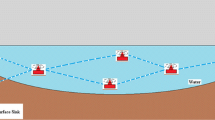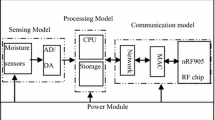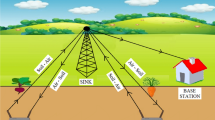Abstract
Radio frequency electromagnetic, acoustics, optics, and near field magnetic induction are the primary wireless communication carriers that are employed for underwater and underground communication. Radio waves are preferred for shallow-water and underground communication because of their high data rate over other communication carriers. This inherently motivated our research to find new capabilities with radio wave communication in conducting mediums, including underwater and underground regions. The focus of our research aims at experimentally reducing path loss for radio waves. Proposed communication model involves a communicating node present in the terrestrial region with air as the medium; and a receiving node either buried underneath soil or submerged underwater. The research focuses on assessing the impact of the incidence angle of the signal affecting path loss when the transmitting signal travels through air–water and air-ground interface. The simulation results show that path loss becomes more with the increase in angle of incidence of the propagating signal.








Similar content being viewed by others
References
Al-Shamma’a AI, Shaw A, Saman S (2004) Propagation of electromagnetic waves at MHz frequencies through seawater. IEEE Trans Antennas Propag 52(11):2843–2849. https://doi.org/10.1109/TAP.2004.834449
Banaseka FK, Franklin H, Katsriku FA, Abdulai JD, Ekpezu A, Wiafe I (2021) Soil medium electromagnetic scattering model for the study of wireless underground sensor networks. Wirel Commun Mob Comput. https://doi.org/10.1155/2021/8842508
Bogue R (2008) Sensing with electromagnetic radiation: a review. Part 1: short wavelengths. Sens Rev 28(3):189–193. https://doi.org/10.1108/02602280810882526
Bogue R (2009) Sensing with electromagnetic radiation: a review. Part 2: long wavelengths. Sens Rev 29(3):203–210. https://doi.org/10.1108/02602280910967611
Chaamwe N, Liu W, Jiang H (2010) Wave propagation communication models for wireless underground sensor networks. In: IEEE 12th international conference on communication technology, IEEE. https://doi.org/10.1109/ICCT.2010.5689034
Che X, Wells I, Dickers G, Kear P, Gong X (2010) Re-evaluation of RF electromagnetic communication in underwater sensor networks. IEEE Commun Mag 48(12):143–151. https://doi.org/10.1109/MCOM.2010.5673085
Chipman RA, Lam WST, Young G (2018) Polarized light and optical systems. CRC Press
Eaton JW, Bateman D, Hauberg S (1997) GNU octave. London: network theory
Elrashidi A, Elleithy A, Albogame M, Elleithy K (2012) Underwater wireless sensor network communication using frequency 2.4 GHz. In: CNS’ 12th proceedings of 15th communication and networking simulation symposium
Gupta M, Sinha A (2021) Enhanced-AES encryption mechanism with S-box splitting for wireless sensor networks. Int J Inf Technol 13:933–941
Hansen JS (2011) GNU octave: beginner’s guide: become a proficient octave user by learning this high-level scientific numerical tool from the ground up. Packt Publishing Ltd.
Hattab G, El-Tarhuni M, Al-Ali M, Joudeh T, Qaddoumi N (2013) An underwater wireless sensor network with realistic radio frequency path loss model. Int J Distrib Sens Netw 9(3), article ID 508708. https://doi.org/10.1155/2F2013/2F508708
Huisman JA, Bouten W, Vrugt JA, Ferré PA (2004) Accuracy of frequency domain analysis scenarios for the determination of complex dielectric permittivity. Water Resour Res 40(2):1–12. https://doi.org/10.1029/2002WR001601
Jaiswal P, Sinha A (2016) Stable geographic forwarding with link lifetime prediction in mobile adhoc networks for battlefield environment. HCIS 6(1):1–18
Jiang S, Georgakopoulos S (2011) Electromagnetic wave propagation into fresh water. J Electromagn Anal Appl 3(7):261–266. https://doi.org/10.4236/jemaa.2011.37042
Khan MTR, Ahmed SH, Jembre YZ, Kim D (2019) An energy-efficient data collection protocol with AUV path planning in the Internet of Underwater Things. J Netw Comput Appl 135:20–31
Li S, Qu W, Liu C, Qiu T, Zhao Z (2019) Survey on high reliability wireless communication for underwater sensor networks. J Netw Comput Appl 148:102446
Metz J (2014) The geometry of Snell’s law. Phys Teach 52(3):177. https://doi.org/10.1119/1.4865526
Muduli L, Mishra DP, Jana PK (2018) Application of wireless sensor network for environmental monitoring in underground coal mines: a systematic review. J Netw Comput Appl 106:48–67
Nowsheen N, Karmakar G, Kamruzzaman J (2016) PRADD: a path reliability-aware data delivery protocol for underwater acoustic sensor networks. J Netw Comput Appl 75:385–397
Pal A et al (2020) Taking wireless underground: a comprehensive summary. ACM Trans Sens Netw 1(1):1–44
Peplinski NR, Ulaby FT, Dobson MC (1995) Dielectric properties of soils in the 0.3–1.3-GHz range. IEEE Trans Geosci Remote Sens 33(3):803–807. https://doi.org/10.1109/36.387598
Poncela J, Aguayo MC, Otero P (2012) Wireless underwater communications. Wirel Pers Commun 64(3):547–560
Prasad P (2015) Recent trend in wireless sensor network and its applications: a survey. Sens Rev 35(2):229–236. https://doi.org/10.1108/SR-08-2014-683
Ritsema CJ et al (2009) A new wireless underground network system for continuous monitoring of soil water contents. Water Resour Res. https://doi.org/10.1029/2008WR007071
Sadeghioon AM, Chapman DN, Metje N, Anthony CJ (2017) A new approach to estimating the path loss in underground wireless sensor networks. J Sens Actuator Netw 6(3):1–18. https://doi.org/10.3390/jsan6030018
Salam A, Raza U (2020) On burial depth of underground antenna in soil horizons for decision agriculture. In: International conference on internet of things. Springer, Cham, pp 17–31. https://doi.org/10.1007/978-3-030-59615-6_2
Silva AR, Vuran MC (2010) Communication with aboveground devices in wireless underground sensor networks: an empirical study. In: 2010 IEEE international conference on communications, IEEE, pp 1–6
Silva AR, Vuran MC (2009) Empirical evaluation of wireless underground-to-underground communication in wireless underground sensor network. In: International conference on distributed computing in sensor systems. Springer, Berlin, pp 231–244
Singh G, Kumar M (2020) Performance analysis of electromagnetic (EM) wave in sea water medium. Wirel Netw 26(3):2125–2135. https://doi.org/10.1007/s11276-019-02054-y
Sinha A, Lobiyal DK (2011) An entropic approach to data aggregation with divergence measure-based clustering in sensor network. In: International conference on advances in computing and communications. Springer, Berlin, pp 132–142
Sinha A, Lobiyal DK (2014) Probabilistic data aggregation in information-based clustered sensor network. Wirel Pers Commun 77(2):1287–1310
Sun Z, Akyildiz IF (2010) Magnetic induction communications for wireless underground sensor networks. IEEE Trans Antennas Propag 58(7):2426–2435. https://doi.org/10.1109/TAP.2010.2048858
Tahir M, Ali I, Yan P, Jafri MR, Zexin J, Xiaoqiang D (2020) Exploiting W. Ellison model for seawater communication at gigahertz frequencies based on world ocean atlas data. ETRI J 42(4):575–584. https://doi.org/10.4218/etrij.2018-0492
Thakur D, Kumar Y, Kumar A, Singh PK (2019) Applicability of wireless sensor networks in precision agriculture: a review. Wirel Pers Commun 107(1):471–512
Tiusanen J (2009) Wireless soil scout prototype radio signal reception compared to the attenuation model. Precis Agric 10(5):372–381
Uribe C, Grote W (2009) Radio communication model for underwater WSN. In: 2009 3rd international conference on new technologies, mobility and security, IEEE, pp 1–5
VK5BR, Lloyd B (1987) Underwater radio communication. Originally published in Amateur Radio
Wang J, Shi W, Lingwei Xu, Zhou L, Niu Q (2017) Design of optical-acoustic hybrid underwater wireless sensor network. J Netw Comput Appl 92:59–67
Yu X, Wu P, Han W, Zhang Z (2012) Overview of wireless underground sensor networks for agriculture. Afr J Biotechnol 11(17):3942–3948. https://doi.org/10.5897/AJBX11.020
Zemmour H, Baudoin G, Diet A (2016) Soil effects on the underground-to-aboveground communication link in ultrawideband wireless underground sensor networks. IEEE Antennas Wirel Propag Lett 16:218–221. https://doi.org/10.1109/LAWP.2016.2570298
Funding
The authors declare they have no financial interests.The authors did not receive support from any organization for the submitted work.
Author information
Authors and Affiliations
Corresponding author
Ethics declarations
Conflict of interest
The authors have no competing interests to declare that are relevant to the content of this article.
Human rights
The authors have not used any research involving human participants, their data or any biological material.
Informed consent
All the authors have consent towards the publication process.
Additional information
Publisher's Note
Springer Nature remains neutral with regard to jurisdictional claims in published maps and institutional affiliations.
Rights and permissions
Springer Nature or its licensor (e.g. a society or other partner) holds exclusive rights to this article under a publishing agreement with the author(s) or other rightsholder(s); author self-archiving of the accepted manuscript version of this article is solely governed by the terms of such publishing agreement and applicable law.
About this article
Cite this article
Saini, P., Singh, R.P. & Sinha, A. Path loss assessment of electromagnetic signal on air–sea and air–soil boundary in sensor networks. Int J Syst Assur Eng Manag 15, 2238–2247 (2024). https://doi.org/10.1007/s13198-023-02239-x
Received:
Revised:
Accepted:
Published:
Issue Date:
DOI: https://doi.org/10.1007/s13198-023-02239-x




